Whether you run into one of these snakes in the woods or are brushing up on your local snakes, it’s good to know a bit about black snakes.
While black snakes may all look the same at first glance, they actually have unique details to set them apart from each other. These snakes also vary in their habitats but do overlap in some.
One of the main reasons that people want to differentiate between black snakes is because they’re trying to avoid venomous species, such as the cottonmouth. The cottonmouth is highly venomous and poses a threat to humans and pets. As a result, other snakes on our list are mistakenly killed out of fear every year.
We will look at some facts about eight Alabama blacksnakes, so you’ll be prepared for what you might encounter in Alabama.
Is it Normal to Find Snakes in Alabama?
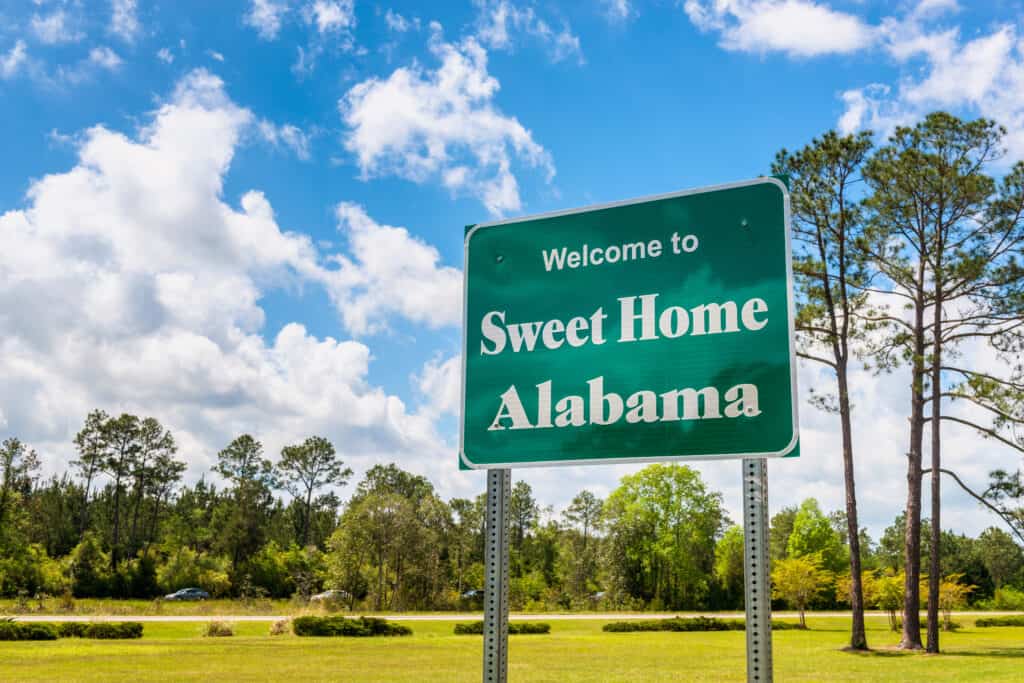
Alabama is home to over 40 different species of snakes!
©Allard One/Shutterstock.com
Yes, it is normal to find snakes in Alabama as the state has a diverse population of snake species.
Alabama is home to over 40 different species of snakes, which include both venomous and nonvenomous varieties. Some of the most common snake species found in Alabama include the Eastern Diamondback Rattlesnake, the Copperhead, the Cottonmouth, the Eastern Garter snake, the Eastern Kingsnake, the Eastern Milk snake, and the Eastern Hognose snake.
Alabama also has a number of rare and endangered snake species, such as the Alabama Redbelly snake and the Eastern Indigo snake. So it’s not uncommon to find snakes in Alabama, and it’s important to understand which snakes are dangerous and which are not.
Lifespan: How Long Do Snakes Live?
The lifespan of snakes can vary widely depending on the species, with some living for decades and others only a few years. Some species, such as pythons and boas, have the potential to live over 30 years in captivity.
Other species, like garter snakes, have a shorter lifespan, around 3-4 years. The longevity of a snake is also affected by the conditions it lives in, with wild snakes living shorter lives than those in captivity.
Additionally, diet, habitat, genetics, and overall health all play a role in how long a snake lives.
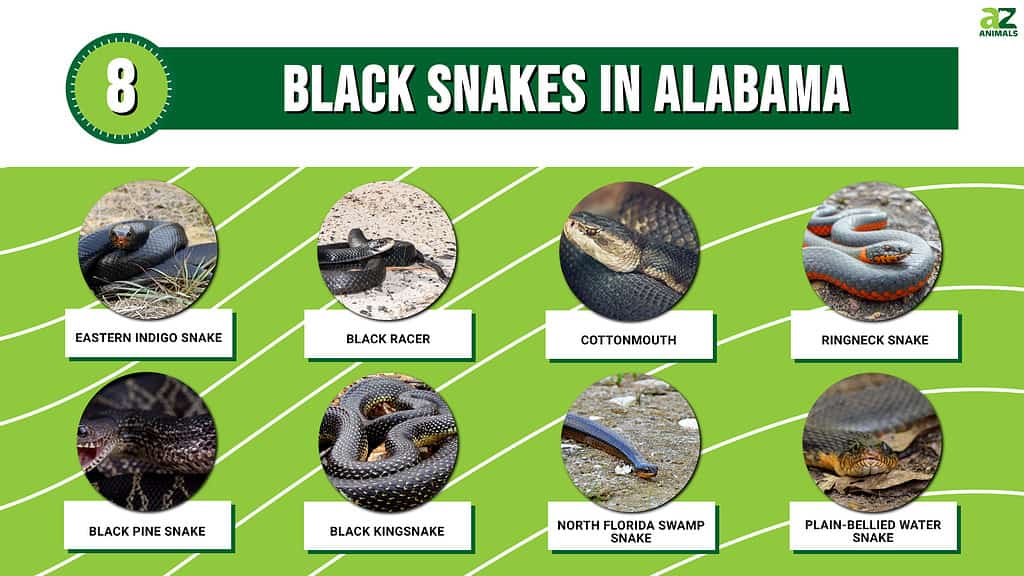
1. Eastern Indigo Snake
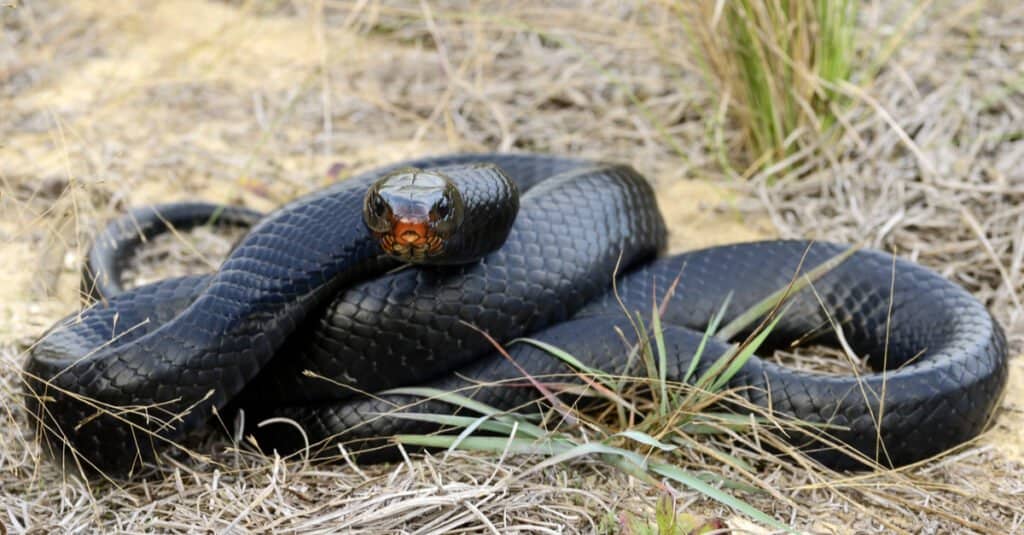
Eastern indigo snakes are black except for their chins.
©Patrick K. Campbell/Shutterstock.com
This is a nonvenomous snake that can reach up to seven feet long. The eastern indigo snake is mostly black, but it has a cream chin. Sometimes, it can appear blueish in the right light. It’s not a snake that moves fast.
This snake used to be in Alabama, but human development shortened its range to Georgia and Florida. The eastern indigo snake prefers sandhill and longleaf pine habitats. Efforts are being made to restore this habitat in Alabama so reintroduced snakes can re-inhabit the area.
In Alabama, these snakes rely on the gopher tortoise for food and to use their burrows as shelters. The range of this tortoise has also been affected, which may have had an impact on the indigo snake’s range.
2. Black Racer
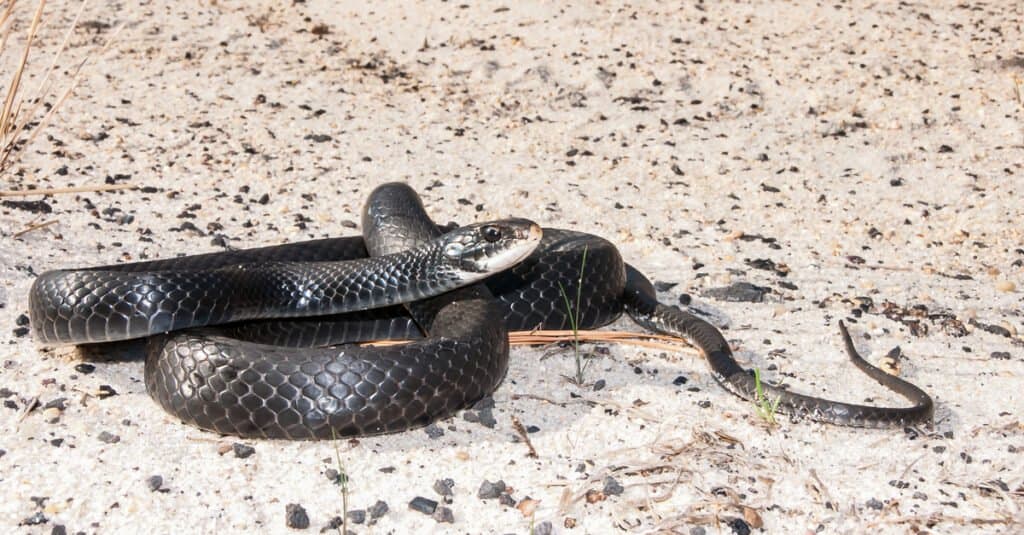
The southern black racer snake is black, although its chin and belly can have color.
©Jay Ondreicka/Shutterstock.com
Often mistaken for the eastern indigo above, the black racer is another type of Alabama blacksnake. It’s nonvenomous, though it’ll put on a display like it is venomous when threatened.
Black racers grow up to six feet long, but they’re usually between three and five feet long. These snakes are slender for their size. They’ll first try to escape before things escalate into a confrontation, but they are aggressive if cornered.
Their upper body is black, while their belly can be black or gray. They have smooth scales and brown eyes. Sometimes they have a white spot on their chin. The juveniles have blotches and are a bit lighter in color than the adults.
3. Cottonmouth
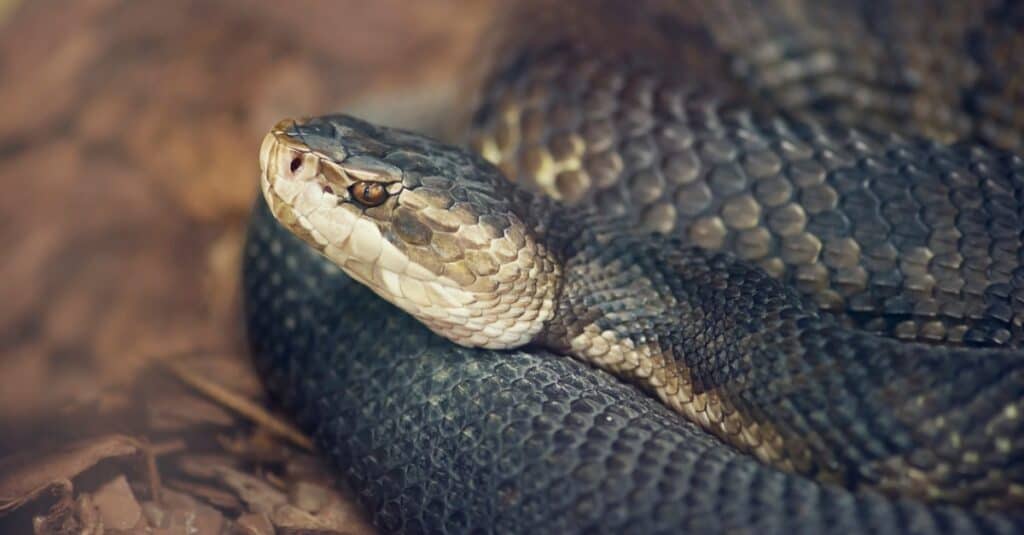
The cottonmouth, or water moccasin, usually looks all black though it can come in various colors.
©iStock.com/Saddako
Cottonmouths come in other dark colors, but black is the most common. These snakes are known as water moccasins and are highly venomous. They’re called cottonmouths because they bare their almost cotton-white mouths when threatened.
Other nonvenomous snakes are often mistaken for cottonmouths including some on our list. The black racer and the plain-bellied water snake are examples of these snakes.
4. Ringneck Snake
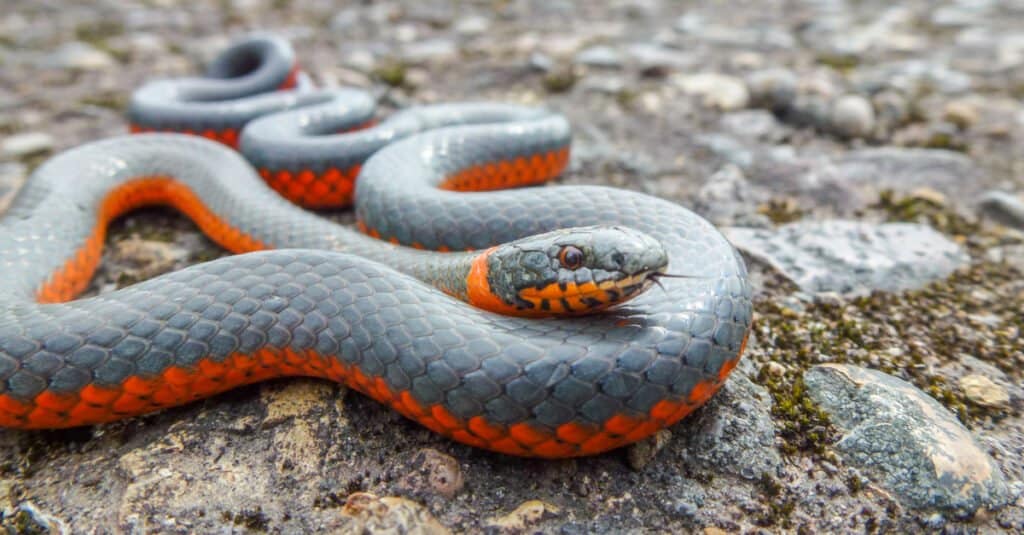
Ringneck snakes have blue or black topsides.
©Tom Fenske/Shutterstock.com
Ringneck snakes are small, averaging in at around 18 inches long. Some ringnecks are more blue than black, but enough are black that they’re worth adding to this list. Their necklace ring around their neck makes them one of the coolest-looking snakes in the world.
These snakes have a little cream-colored or yellow band around their neck, and their belly is also light. They’re nonvenomous, and because they’re so docile, they’re often kept as pets. They’re known to curl up in their owner’s hand which is possible because they’re so small.
When ringneck snakes bite, their back fangs don’t pierce the skin, so they’re harmless. They like to munch on earthworms, slugs, frogs, and lizards. They’ll also eat juvenile snakes.
5. Black Pine Snake
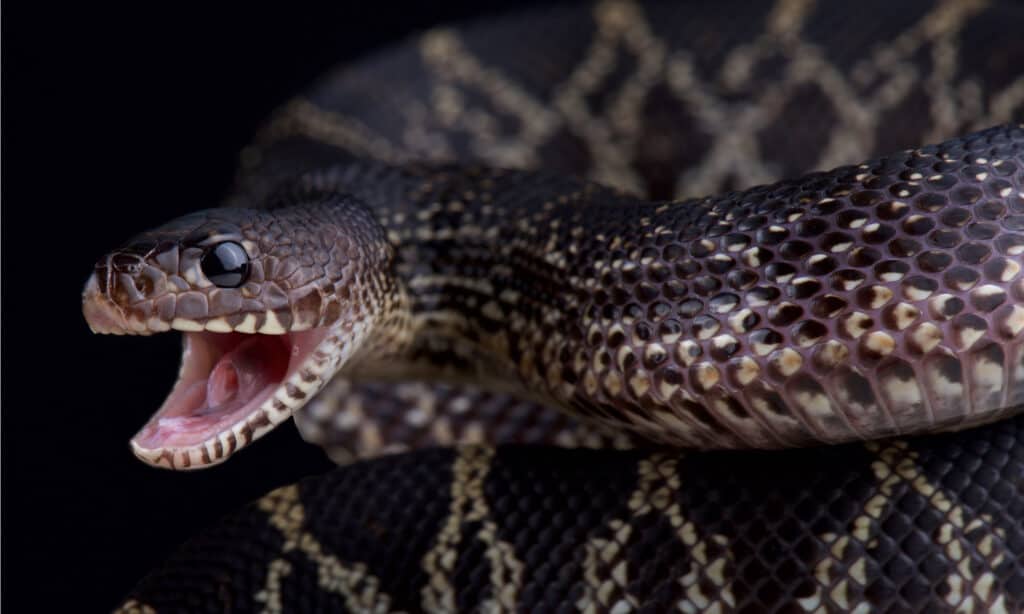
Black pine snakes are endangered in Alabama.
©reptiles4all/Shutterstock.com
West of Mobile Bay lives the endangered black pine snake, another Alabama blacksnake. Its range also extends into Mississippi and Louisiana. This snake likes dry sandy ground and prefers tree canopies that are closed.
This is a threatened species, as the conversion of their territory into housing and farmland has been happening at a faster pace than reforestation. Black pine snakes like to eat birds and their eggs, pocket gophers, and other small mammals.
6. Black Kingsnake

Kingsnakes are mostly black while also seeming pixelated.
©Matt Jeppson/Shutterstock.com
The kingsnake has some bits of yellow on it even though it is mostly black, helping distinguish it. Black kingsnakes have smooth scales, and they have almost a pixelated patterning on their belly, though they look black when they’re moving on the ground.
Native to Alabama, these snakes are popular snakes to keep as pets because they’re easily tamed after being caught in the wild. Wild snakes will put up a fight that includes tail rattling, using musk, and biting. They grow up to five feet long, so their enclosure will need to be quite big if you’re planning on owning one.
Black kingsnakes are constrictors that prey on the usual snake munchable, but they are also able to eat venomous snakes. That’s because they’re immune to pit-viper venom.
7. North Florida Swamp Snake
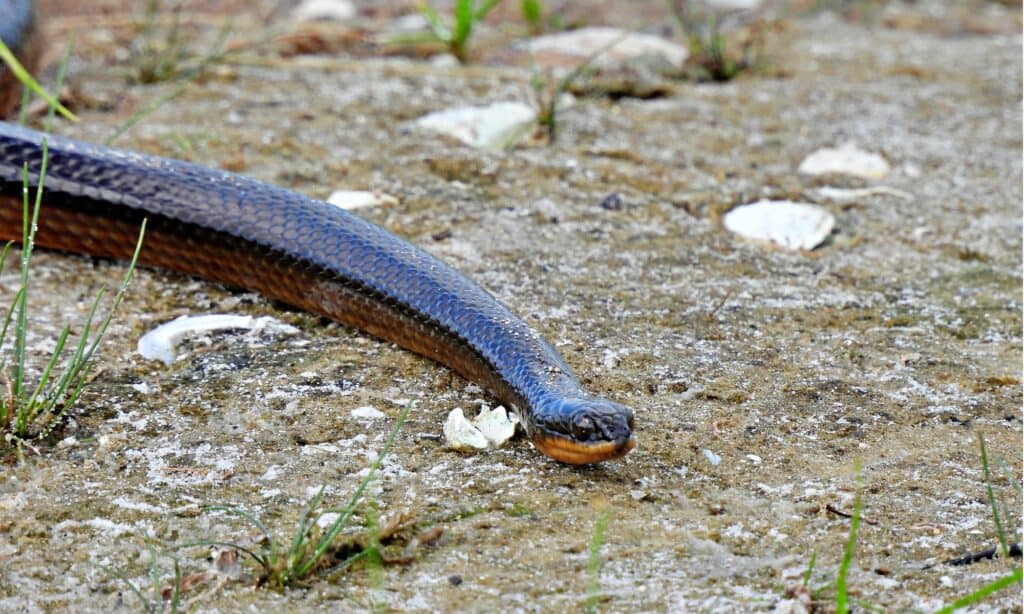
The North Florida swamp snake is black with a red belly.
©iStock.com/passion4nature
North Florida swamp snakes have a red belly, but a predominantly black belly that can be seen while they’re slithering around. Their scales may look keeled but they’re actually smooth. These snakes are aquatic and non-venomous.
North Florida swamp snakes are usually about a foot and a half long. The northwestern part of their range is in Alabama, as they like the coastal plain. They live in swamps, ponds, ditches, lakes, and canals. Anywhere with water and plenty of vegetation works for them.
8. Plain-Bellied Water Snake

This snake is sometimes divided into subspecies based on differentiation in coloration. It’s been shown, though, that there’s no genetic variance. The differences are just phenotypical which means it’s just the natural range of looks that occur. Some dogs are huge and black, some dogs are tiny and white. It’s the same for snakes.
Plain-bellied water snakes grow up to four feet long and they’re nonvenomous. Salamanders, crayfish, frogs, toads, and fish are all on the plain-bellied water snake’s menu.
A unique feature of this snake is that it retreats to land when it feels threatened instead of remaining or hiding in the water.
Summary
Out of the 8 species of Alabama blacksnakes, only the cottonmouth is venomous, meaning if you see these other snakes it is safe to leave them alone! Cottonmouths, however, account for less than 1% of the 8,000 snake bites in the U.S. each year. As long as you take precautions, it is easy to stay away from these dangerous serpents.
| Venomous | Non-Venomous |
|---|---|
| Cottonmouth (water moccasin) | Eastern Indigo Snake |
| Black Racer Snake | |
| Ringneck Snake | |
| Black Kingsnake | |
| North Florida Swamp Snake | |
| Plain-bellied Water Snake |
Other Dangerous Animals Found In Alabama
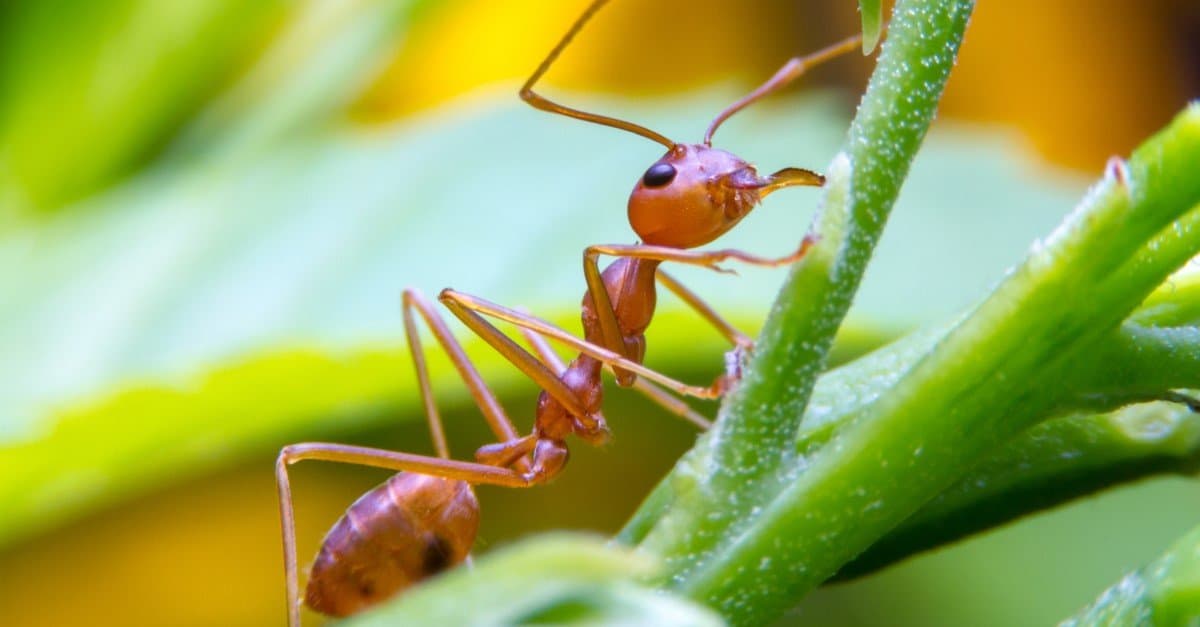
Fire ant bites will cause a burning sensation that will be followed by intense itching.
©wnarong/Shutterstock.com
Some of the most dangerous animals in Alabama also happen to be some of the smallest. The fire ant, which includes over 200 species, are biting and stinging ants in the genus Solenopsis. When they bite, they inject venom into their victims which causes a burning sensation that will be followed by intense itching that may turn into welts. The venom can remain in your system for a few days and in rare cases, can cause a severe life-threatening allergic reaction.
The Chilean recluse spider is one of the three highly venomous spiders in the United States, the other two being the brown recluse and the black widow. This Chilean arachnid is recognized by its characteristic violin marking on the thorax, where the legs connect to the body, although it is similar in appearance to the brown recluse it is not native to the United States and isn’t as commonly found. A bite from this spider will cause necrosis, death to the tissue surrounding the bite area, and possibly kidney failure.
Other Reptiles Found In Alabama
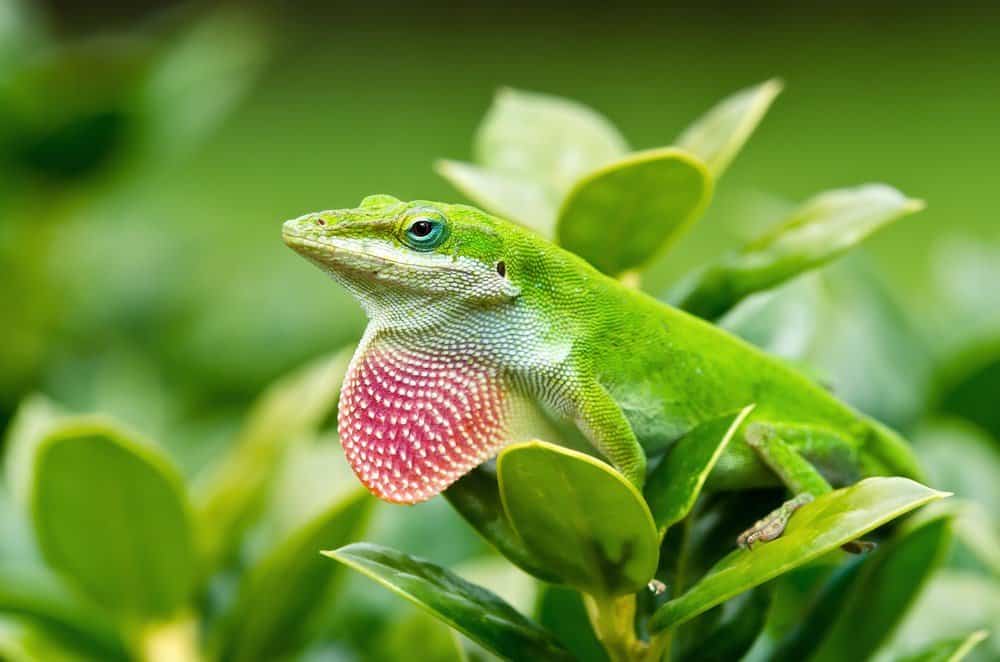
Green Anole lizard (Anolis carolinensis) showing off his bright pink dewlap.
©Leena Robinson/Shutterstock.com
Alabama is a haven for many different types of reptiles. There are 93 different types of native reptiles alone, which include turtles, lizards, and snakes. Among the native lizard species found in the state, the green anole is the only native lizard capable of changing color. Commonly found throughout the Southwest, many refer to this lizard as a chameleon, although it is not related to the true family of chameleons, or Old World lizards, and rather belongs to the iguana family, which are New World lizards.
The male anole is known for its bright pink or reddish dewlap or throat pouch, and they are able to change color from green to brown to grey, depending on a variety of factors, not just as a camouflage. Humidity, temperature, mood and their surroundings are all factors that contribute to the change in color.
The photo featured at the top of this post is ©
Discover the "Monster" Snake 5X Bigger than an Anaconda
Every day A-Z Animals sends out some of the most incredible facts in the world from our free newsletter. Want to discover the 10 most beautiful snakes in the world, a "snake island" where you're never more than 3 feet from danger, or a "monster" snake 5X larger than an anaconda? Then sign up right now and you'll start receiving our daily newsletter absolutely free.
Thank you for reading! Have some feedback for us? Contact the AZ Animals editorial team.






